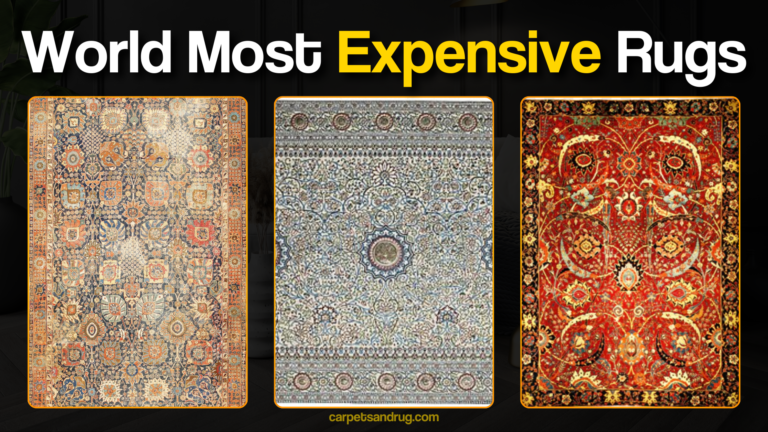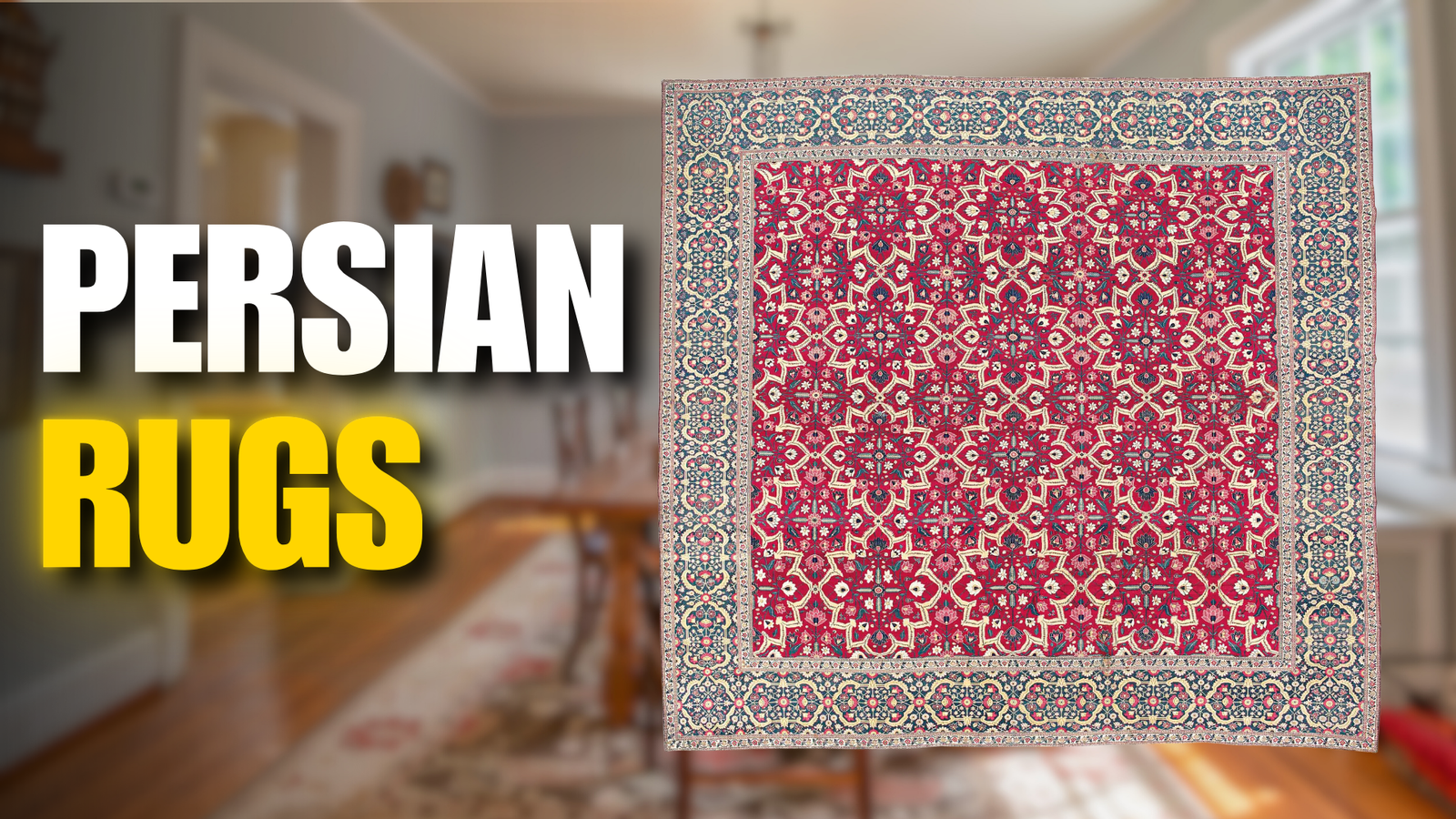
Persian Rugs: A Rich Cultural Heritage
Persian rugs are among the world’s most enduring artistic traditions, combining practical function with exceptional beauty. These textile masterpieces have impressed people across cultures for thousands of years, working both as floor coverings and as art pieces that communicate Persian heritage and craftsmanship.
Table of Contents
The Historical Roots of Persian Rug Making
The art of Persian rug weaving dates back over 2,500 years, with evidence suggesting that nomadic tribes in ancient Persia (modern-day Iran) began crafting rudimentary floor coverings for practical purposes. As civilization advanced, so did the sophistication of these textiles. The oldest known Persian carpet, the Pazyryk carpet, discovered in Siberia and dating to approximately 500 BCE, demonstrates that the craft had already achieved remarkable sophistication by this early period.
During the Sassanid dynasty (224-651 CE), Persian carpet weaving evolved from a nomadic craft to a refined art form, with royal workshops producing increasingly elaborate designs. The Arab conquest of Persia in the 7th century introduced Islamic artistic influences, while the Seljuk and Mongol periods further enriched the tradition with new motifs and techniques.
The golden age of Persian carpet weaving arrived during the Safavid dynasty (1501-1736). Shah Abbas I established royal workshops where master weavers created carpets of unprecedented intricacy and beauty. These carpets became diplomatic gifts and valuable trade commodities, spreading Persian design aesthetics throughout Europe and Asia.
Regional Styles and Distinctive Characteristics
One of the most fascinating aspects of Persian rugs is the incredible diversity of regional styles, each with distinctive patterns, color palettes, and weaving techniques. These regional differences reflect local cultural influences, available materials, and historical developments:
Tabriz
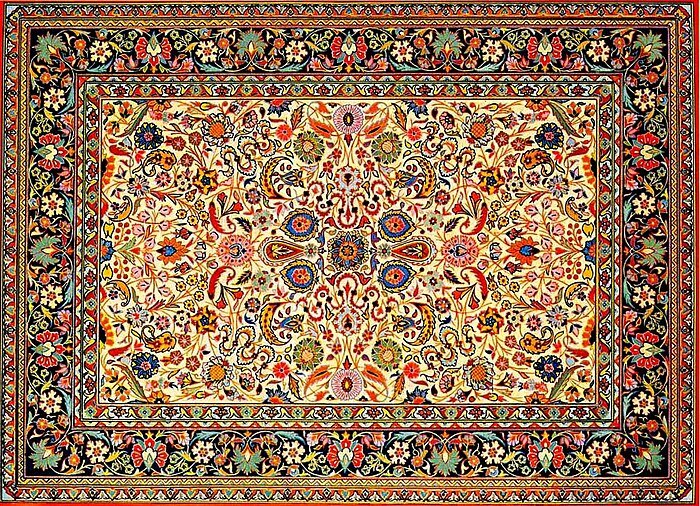
Originating from northwestern Iran, Tabriz carpets are known for their intricate medallion designs, fine weaving, and rich color palette. The weavers of Tabriz often incorporate historical and literary themes into their carpets, with exceptional attention to detail.
Isfahan
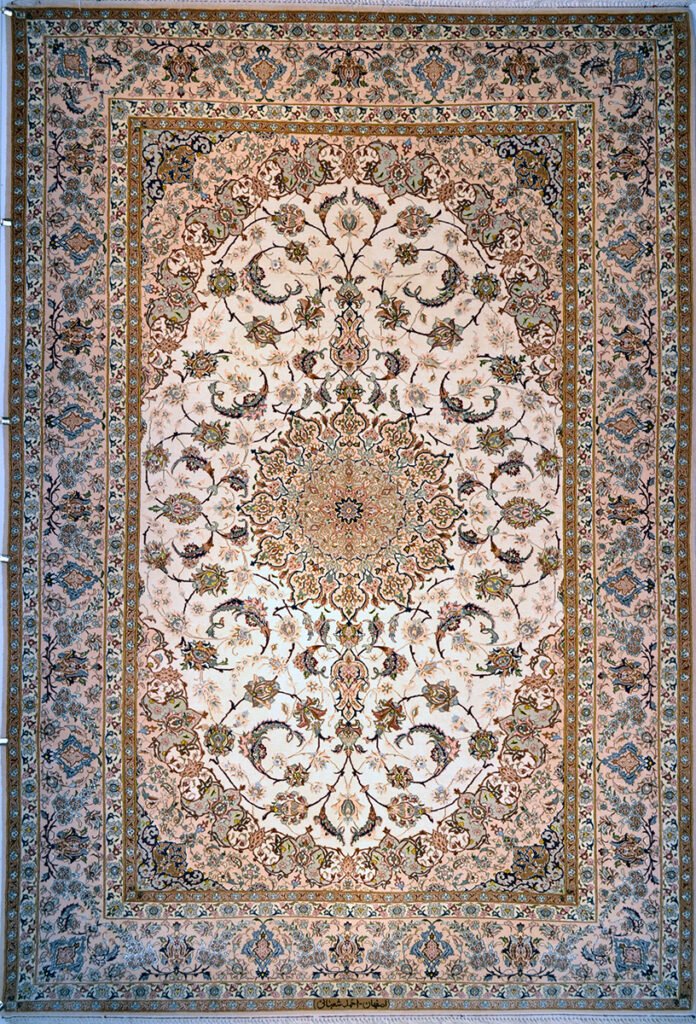
Considered among the finest Persian rugs, Isfahan pieces feature elaborate floral patterns, curved lines, and a central medallion design. The color palette typically includes ivory, blue, and red, with silk often incorporated to highlight specific design elements.
Qom
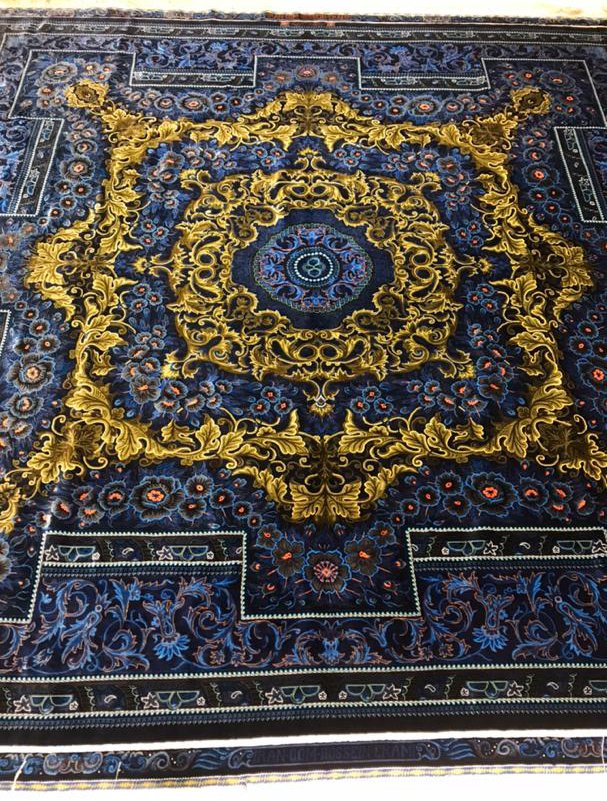
Despite being relatively new to the Persian rug tradition, Qom has quickly established a reputation for producing extraordinarily fine silk rugs with high knot density. These luxurious carpets often feature intricate designs with vibrant colors and exceptional detail.
Kashan
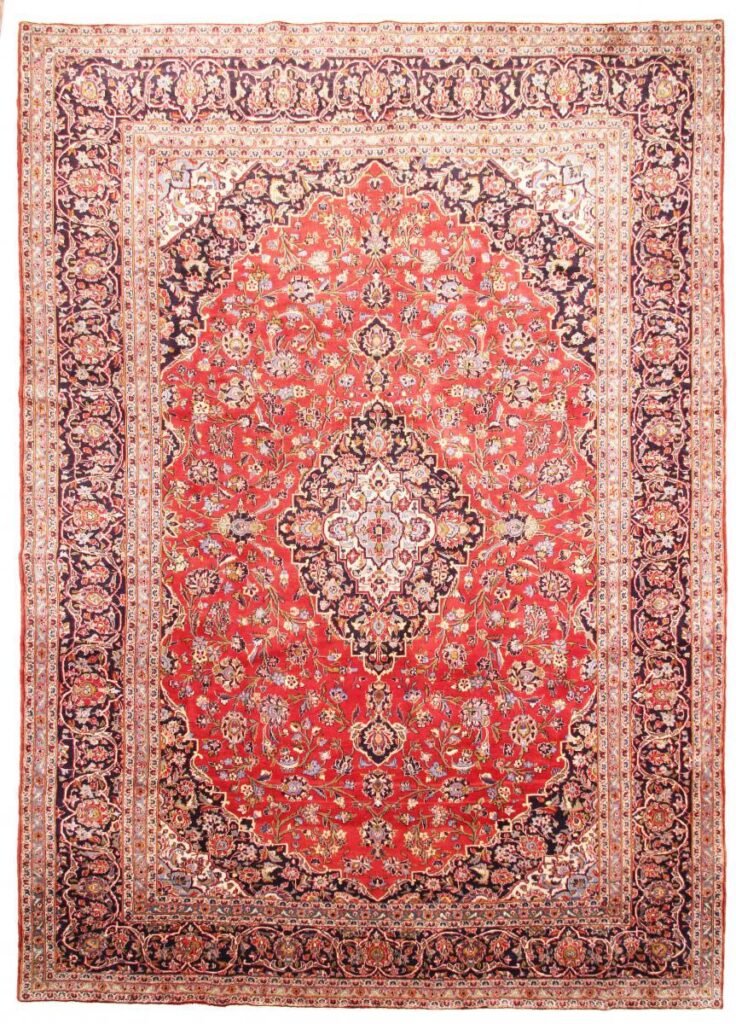
Known for their rich color palette dominated by deep reds and blues, Kashan rugs typically feature a central medallion surrounded by floral motifs. These carpets are appreciated for their excellent quality and traditional aesthetics.
Heriz
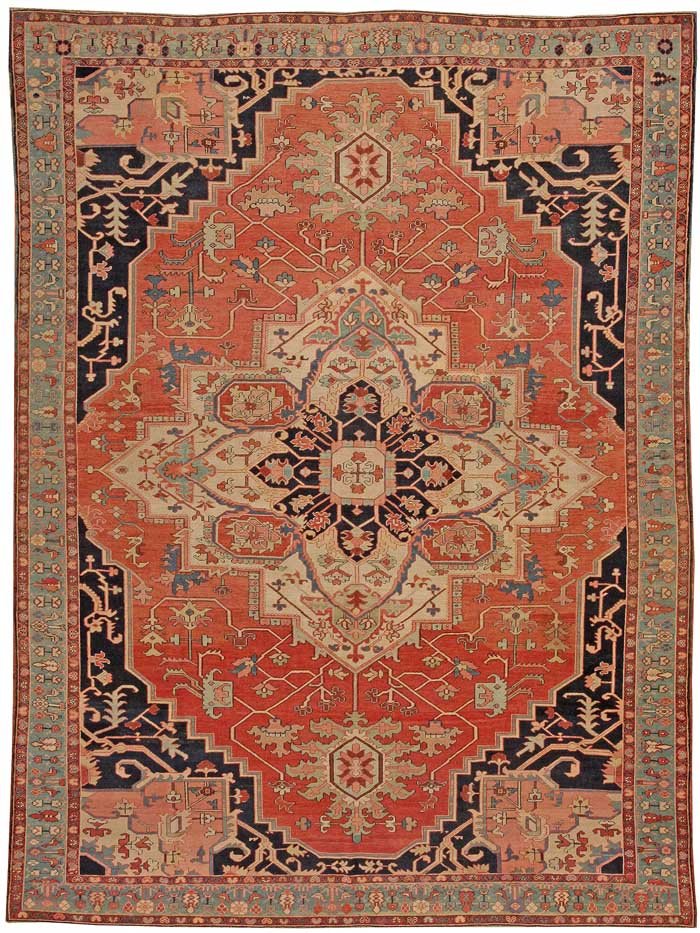
From the mountainous region of northwestern Iran, Heriz rugs are characterized by bold geometric patterns and a sturdy construction. Their distinctive rust-red backgrounds and navy blue accents make them immediately recognizable.
Nain

Renowned for their exceptional fineness, Nain rugs feature delicate floral and arabesque patterns on ivory or light blue backgrounds. These carpets often incorporate silk to highlight intricate design elements.
Kerman
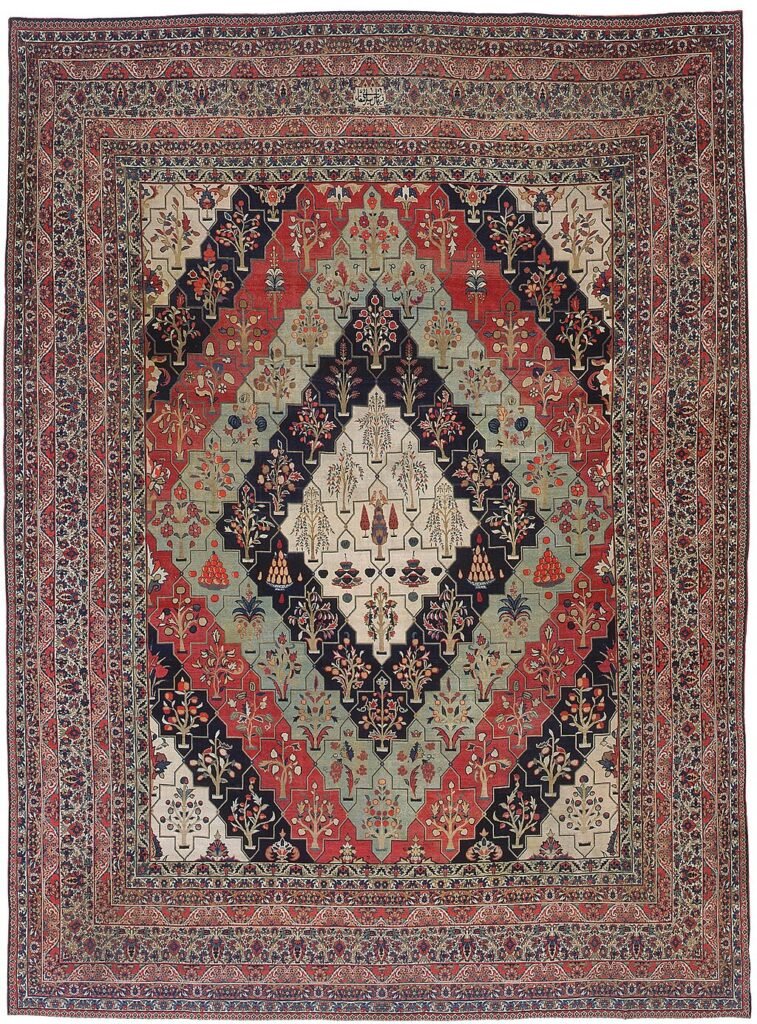
Kerman rugs are known for their varied designs, which range from all-over patterns to central medallions with corner pieces. Their typically pastel color palette and high-quality wool make them both beautiful and durable.
Materials and Craftsmanship
The extraordinary quality of Persian rugs stems from both excellent materials and exceptional craftsmanship:
Materials
Traditional Persian rugs utilize several key materials:
- Wool: The primary material for most Persian rugs, wool from highland sheep provides durability, softness, and excellent dye absorption. The best wool comes from sheep raised in mountainous regions, where the harsh climate produces wool with high lanolin content and long fibers.
- Silk: Used in the finest rugs, silk allows for extremely detailed patterns due to its fine threads. Silk rugs are typically hung as wall art rather than used as floor coverings due to their delicate nature.
- Cotton: Often used for the foundation (warp and weft) of the rug, cotton provides structural stability and prevents warping.
- Natural Dyes: Historically, Persian rug makers utilized natural dyes derived from plants, insects, and minerals. These included madder root (red), indigo (blue), larkspur (green), saffron (yellow), and walnut husks (brown). While synthetic dyes are now common, the finest rugs still employ natural dyes for their subtle color variations and longevity.
Weaving Techniques
The creation of a Persian rug involves several intricate techniques:
- Knotting: The most distinctive feature of Persian rugs is the hand-knotting technique. The Persian knot (also called the Senneh knot) allows weavers to create highly detailed patterns. Knot density, measured in knots per square inch (KPSI), indicates the quality and fineness of a rug. Fine Persian rugs can contain 400-800 KPSI, with exceptional pieces exceeding 1,000 KPSI.
- Warping and Wefting: Before knotting begins, weavers set up the foundation of vertical warp threads (usually cotton) on a loom. After each row of knots, horizontal weft threads are passed through to secure the knots.
- Design Creation: Master weavers either follow cartoons (design blueprints) or work from memory for traditional patterns. The ability to translate complex designs into thousands of individual knots requires exceptional skill and patience.
- Finishing: After weaving is complete, the rug undergoes multiple finishing steps, including clipping excess yarn, washing to remove dirt and excess dye, and stretching to ensure proper shape.
A single high-quality Persian rug can take months or even years to complete, with large, intricate designs requiring several artisans working simultaneously on the same piece.
Meaning Behind Persian Rug Patterns
Persian rugs do more than decorate spaces—they carry cultural meaning. The patterns and motifs in these carpets tell stories and contain symbolic messages:
Geometric Patterns
Geometric designs, particularly common in rugs from tribal and nomadic traditions, often represent protection and good fortune. These include:
- Eight-pointed stars: Symbolizing the eight gates of paradise in Islamic tradition
- Diamonds: Representing women and fertility
- Zigzag lines: Depicting water and the importance of this precious resource
Floral and Garden Motifs
The Persian garden, or “paradise garden,” has deeply influenced carpet design:
- The Tree of Life: A central motif symbolizing the connection between heaven and earth
- Flowers: Roses represent beauty and love, while lotus flowers symbolize purity
- Garden layouts: Many carpets depict formal gardens with water channels and flowering plants, reflecting the Persian ideal of paradise
Animal Motifs
While less common in rugs from Islamic periods due to religious restrictions on depicting living beings, animal motifs appear in some Persian carpets:
- Birds: Often nightingales or phoenixes, representing freedom or rebirth
- Lions: Symbolizing power and protection
- Fish: Representing fertility and abundance
Central Medallions
Many Persian rugs feature a prominent central medallion, thought to represent either:
- The dome of a mosque
- A bird’s-eye view of a Persian garden
- The sun or moon
Knowing these symbolic elements helps you appreciate Persian rugs more fully, letting you “read” them as cultural documents rather than seeing them as just beautiful objects.
The Cultural Significance of Persian Rugs
In Persian culture, rugs hold immense significance beyond their aesthetic and functional value:
Social Status and Identity
Historically, the quality, design, and size of a household’s rugs indicated the family’s social standing and regional identity. Village and nomadic groups developed distinctive patterns that conveyed information about their tribal affiliations and cultural traditions.
Dowry and Heritage
High-quality rugs were essential components of a bride’s dowry, representing both financial value and cultural heritage. These rugs would be passed down through generations, becoming family heirlooms that carried ancestral connections.
Spiritual and Religious Significance
In Islamic contexts, prayer rugs (sajjadeh) provide clean surfaces for daily prayers. These specialized rugs typically feature a niche (mihrab) design that points toward Mecca. Beyond prayer rugs, Islamic geometric patterns in carpets often represent the infinite nature of Allah.
Diplomatic Exchange
Throughout history, Persian rugs served as prestigious diplomatic gifts, symbolizing the wealth and cultural sophistication of Persian rulers. These exchanges helped spread Persian design influences throughout Europe and Asia.
The Persian Rug Industry Today
The contemporary Persian rug industry navigates between tradition and innovation:
Preservation of Traditional Techniques
Despite modernization, many communities in Iran maintain traditional rug-making practices. Organizations like the Iranian National Carpet Center work to document and preserve these ancient techniques, ensuring they continue for future generations.
Challenges and Adaptations
The industry faces several challenges, including:
- Competition from machine-made rugs and lower-cost hand-knotted rugs from other countries
- Changing consumer preferences as global design trends shift
- Political tensions and international sanctions affecting export markets
In response, many Iranian weavers have adapted by:
- Developing contemporary designs that appeal to modern aesthetics while maintaining traditional craftsmanship
- Improving marketing and authentication processes to differentiate genuine Persian rugs
- Exploring sustainable practices, including natural dye revival and ethical labor standards
Global Market and Collecting
Persian rugs remain highly valued in the global market. Antique examples can command extraordinary prices at auction, with exceptional pieces selling for millions of dollars. Notable collectors include museums, cultural institutions, and private individuals who appreciate both the artistic merit and investment potential of fine Persian carpets.
Caring for Persian Rugs
Proper care ensures that a Persian rug will maintain its beauty for generations:
Regular Maintenance
- Rotate rugs periodically to ensure even wear
- Vacuum gently using a suction-only vacuum without beater bars
- Address spills immediately by blotting (never rubbing) with absorbent cloth
Professional Cleaning
- Have rugs professionally cleaned every 3-5 years depending on use
- Choose specialists familiar with hand-knotted rugs and traditional materials
- Avoid chemical cleaning methods that can damage natural fibers and dyes
Storage Considerations
- Roll rugs with the pile facing inward (never fold)
- Wrap in acid-free paper and breathable cloth (not plastic)
- Store in a cool, dry environment with proper air circulation
Repairs and Restoration
When damage occurs, skilled restoration by experts who understand traditional techniques can extend a rug’s life without diminishing its value.
Story of Persian Rugs
Persian rugs represent one of humanity’s most significant artistic achievements, showing how function, beauty and cultural expression can work together perfectly. People value them not just for how they look, but for their connection to centuries of human creativity and cultural development.
In today’s world of mass production and disposable items, a Persian rug offers something different—an object made with patience, skill, and deep cultural knowledge. Each knot tied by a weaver continues a tradition that goes back thousands of years.
These rugs appear in museums, expensive homes, and modest living rooms alike. Their patterns show ancient histories, religious ideas, and artistic developments. The skill involved demonstrates what humans can create when techniques are refined across generations.
Looking ahead, Persian rug making faces various challenges and possibilities. By supporting and maintaining this cultural practice, we help ensure that Persian carpet weaving—with its beauty and cultural importance—remains relevant for future generations.

